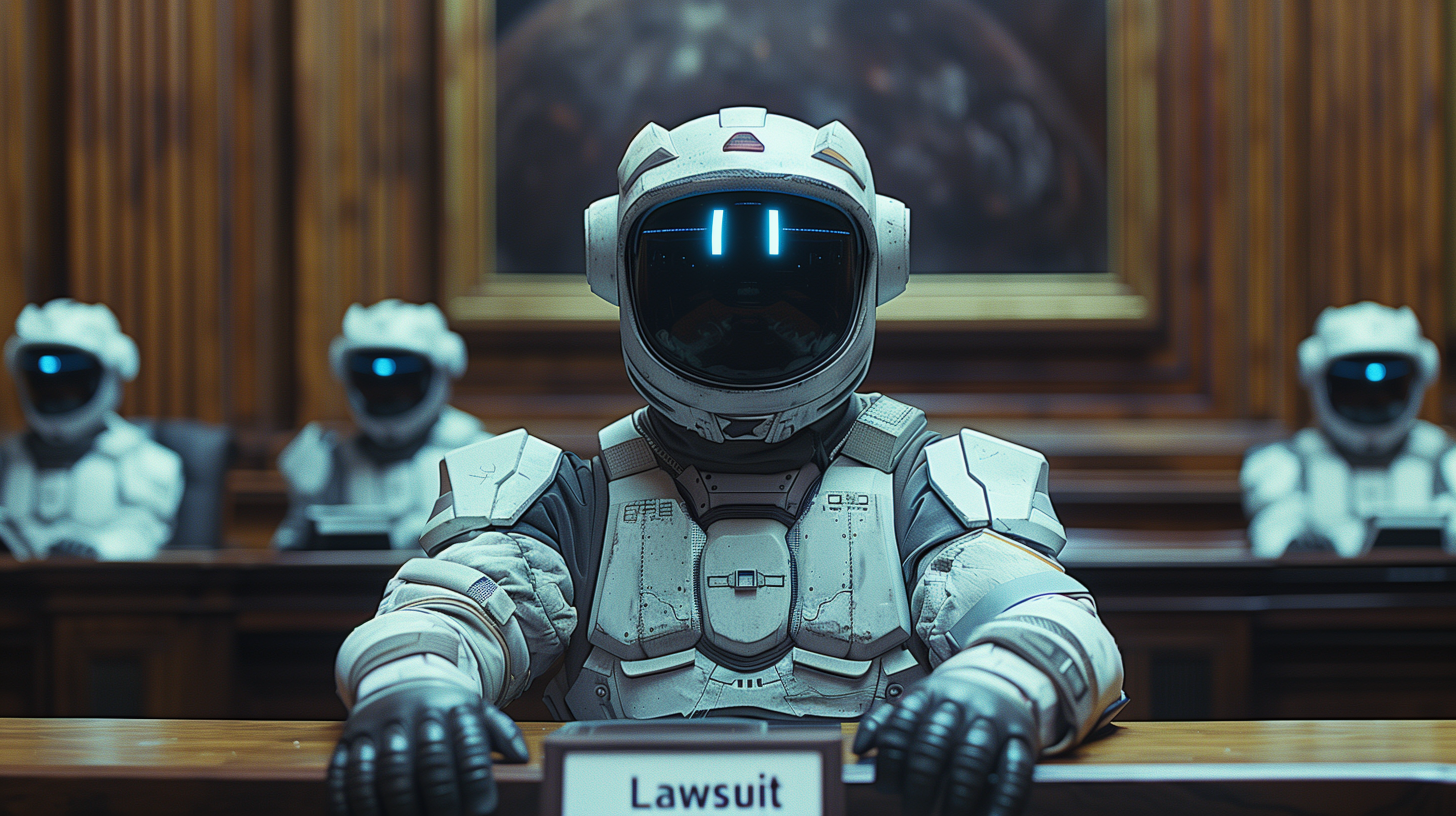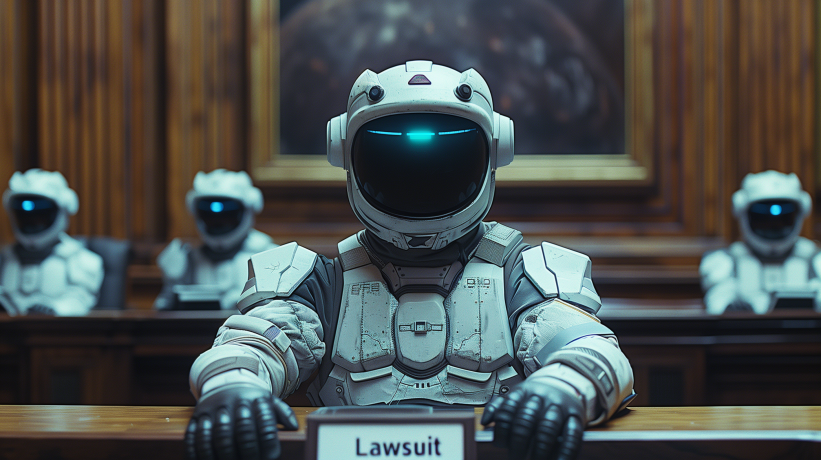
Eight former employees level explosive allegations of pervasive sexual harassment and retaliation at SpaceX in a lawsuit that could redefine executive liability.
by LawInc Staff
June 12, 2024
On June 12, 2024, eight former SpaceX employees filed a lawsuit against the company and CEO Elon Musk, alleging a pervasive culture of sexual harassment and retaliation. The lawsuit claims a workplace environment permeated with sexist behavior, alleging that SpaceX management and HR failed to adequately address complaints and retaliated against employees who spoke up.
This guide provides an in-depth look at the accusations, causes of action, and potential legal and financial fallout for Musk and SpaceX. From the hostile work environment to retaliatory firings, failure to prevent harassment, and potentially unlawful tweets, learn what it takes to build a case that could bring the rocket company back down to earth.
Understanding the key facts, laws, evidence and legal arguments on both sides is crucial for anyone following this high-stakes, high-profile case at the intersection of the #MeToo movement, corporate accountability, and the limits of brash executive speech.
1. Grasp the Shocking Allegations Against Musk & SpaceX
-
- Musk’s Crude Tweets Created Hostile Culture: The lawsuit alleges that Musk’s tweets, while made on his personal account, contributed to a hostile work environment by setting a tone of disrespect towards women and marginalized groups.
- HR Shrugged Off Harassment Complaints: Plaintiffs allege that SpaceX HR failed to take appropriate action in response to their harassment complaints, including conducting thorough investigations and providing adequate remedies.
- Explicit “Jokes” Became Commonplace: Frequent sexual banter, use of crude terms for rocket parts, and naming of conference rooms after strip clubs alleged.
- Women & LGBTQ+ Targeted: Sexist and homophobic remarks, unequal treatment in promotions/assignments, and direct harassment of plaintiffs described.
- 8 Fired for Complaining: Plaintiffs allege they were terminated shortly after sending an open letter to executives about the workplace culture, which SpaceX claims was a violation of company policy.
Examples:
-
- Musk tweeted about SpaceX competing to “get it up” and creating “TITS University.” One plaintiff said male engineers parroted the crude remarks at work.
- Plaintiff Holland-Thielen reported a male colleague making sexual remarks about a chart “going down” but HR failed to act and he remained employed.
- Senior manager Juncosa told a complainant nothing would change because “SpaceX is Elon and Elon is SpaceX” and dissenters could leave.
- An HR rep joked that sexual harassment was like “Fifty Shades of Grey” when asked about criteria for responding to complaints.
- Plaintiff Mallon was passed over for promotion and told she needed to be less “aggressive” and take feedback “more cheerfully” while males’ brashness was accepted.
How to Proceed:
-
- Review the full 45-page complaint for detailed accusations by each plaintiff of the harassment and retaliation they experienced.
- Note the dates of key events like the plaintiffs’ open letter and their subsequent terminations to grasp the alleged retaliation timeline.
- Understand that plaintiffs must show the harassment was severe and pervasive enough to create an abusive work environment, not just isolated incidents.
- Assess if there’s a convincing causal link between the plaintiffs’ harassment complaints/activism and their firing that could prove retaliatory intent.
- Consider the potential impact of Musk’s mercurial online persona and speech on enabling a toxic workplace culture to take hold at his companies.
FAQs:
-
- What does the lawsuit demand from SpaceX? The lawsuit seeks compensatory and punitive damages, attorneys’ fees, and court-ordered changes to SpaceX’s policies and practices to prevent future harassment and discrimination
- How do you prove a hostile work environment? Plaintiffs must show the harassment was severe and pervasive based on a protected characteristic like sex and created an abusive situation.
- What speech is Musk potentially liable for? The lawsuit cites many of his crude tweets as creating a hostile culture, separate from his free speech rights as a private citizen.
- Does it matter if the harassment wasn’t directed at plaintiffs? Not necessarily – secondhand harassment or a generally sexist environment can still be illegal if severe enough.
- What makes the retaliation claim tricky? Plaintiffs engaged in protected activity by reporting harassment, but SpaceX may argue their letter was improper workplace conduct.
2. Examine the 8 Legal Claims Against SpaceX & Musk
-
- Hostile Work Environment Sexual Harassment: Defendants created an abuse work environment rife with sexual harassment so severe and pervasive it altered working conditions.
- Retaliation: SpaceX illegally fired plaintiffs for reporting harassment and objecting to the sexist culture, a protected activity under federal and state law.
- Failure to Prevent Harassment & Retaliation: SpaceX allegedly failed to take reasonable steps to prevent harassment and retaliation as required by law.
- Gender Discrimination: Two plaintiffs claim they were denied equal job opportunities and promotions compared to male peers.
- Whistleblower Retaliation: Plaintiffs say CA labor laws were violated when SpaceX fired them for disclosing info they believed showed illegal activity.
- Wrongful Termination: The 8 allege their firing for opposing harassment violated CA public policy requiring safe, discrimination-free workplaces.
- Unfair Business Practices: Plaintiffs claim the hostile culture and wrongful firings constitute unlawful and unfair business practices under CA law.
Examples:
-
- Holland-Thielen alleges her complaints about sex harassment by a senior engineer weren’t properly investigated and he remained employed.
- The lawsuit claims Musk’s tweets about genital size, sexual acts, and targeting women constitute sexual harassment attributable to the company.
- Two plaintiffs were allegedly told they were fired for being “instrumental” in writing the critical open letter, showing a direct retaliatory link.
- Mallon claims she was passed over for promotions compared to male peers and criticized for masculine traits like aggressiveness.
- Plaintiffs argue their letter and Musk opposition constituted whistleblowing on illegal practices, making their firing unlawful retaliation.
How to Proceed:
-
- Assess whether the sexual harassment alleged meets the “severe and pervasive” legal standard to be actionable under Title VII and CA law.
- Evaluate if the close timing between the plaintiffs’ letter and their firing creates an inference of retaliation to trigger the McDonnell Douglas burden-shifting framework.
- Consider if Musk can be held personally liable for creating a hostile culture via his tweets or if they’re protected free speech.
- Examine the gender discrimination claims in light of SpaceX’s likely defense that the plaintiffs were fired for improper conduct, not their sex.
- Determine if plaintiffs had a reasonable belief SpaceX was breaking the law to qualify for whistleblower protections against retaliation.
FAQs:
-
- What laws are the harassment claims based on? Both Title VII of the 1964 Civil Rights Act and CA’s Fair Employment and Housing Act (FEHA) prohibit sex-based harassment.
- Can tweets really create illegal harassment? The lawsuit raises a novel legal question of whether a CEO’s public statements, even if made on a personal account, can contribute to a hostile work environment if they become part of the company culture.
- What’s the burden of proof for retaliation? Plaintiffs must show protected activity, adverse action, and causal link, then SpaceX must prove a non-retaliatory reason.
- Is an open letter opposing practices protected? Likely if done in a reasonable manner and based on a good-faith belief the practices are illegal, but a novel issue for the court.
- Why are there common law & statutory claims? Plaintiffs are covering their bases to maximize potential damages and hold both SpaceX and Musk liable as an individual.
3. Analyze SpaceX & Musk’s Likely Defenses
-
- Musk’s Speech Protected by 1st Amendment: SpaceX may argue Musk’s tweets are free speech that can’t constitute harassment as a matter of law.
- Plaintiffs Fired for Misconduct, Not Protected Activity: SpaceX claims the letter was an improper attack distributed on company time/resources.
- No Severe or Pervasive Harassment: Defendants will likely argue the “jokes” and incidents weren’t extreme enough to create a hostile work environment.
- HR Responded Appropriately: SpaceX may contend it investigated complaints properly and took action like trainings to prevent harassment.
- Plaintiffs Weren’t Injured: The company could challenge the scope of emotional distress and economic damages plaintiffs are claiming.
Examples:
-
- SpaceX may argue Musk has a 1st Amendment right to tweet crass “jokes” as an individual and they don’t represent official company policy.
- The company claims the plaintiffs misused company time and systems to draft and distribute their critical letter, justifying their firing.
- Defendants will likely claim the harassment incidents were isolated, not physically threatening, and didn’t unreasonably interfere with work.
- SpaceX may contend its sexual harassment training, handbook policies, and HR investigations were sufficient to meet its legal duties.
- The company will likely demand strict proof of alleged emotional distress and lost earnings, arguing plaintiffs failed to mitigate damages.
How to Proceed:
-
- Research case law on whether executives’ public statements can create a hostile work environment even if not directed at plaintiffs.
- Evaluate if SpaceX can prove it would have fired plaintiffs regardless of their harassment complaints and open letter’s protected status.
- Examine if the “jokes” and behavior alleged meet the objective and subjective offense tests for severe and pervasive harassment.
- Assess the reasonableness of SpaceX’s harassment prevention and correction efforts in light of the workplace culture described.
- Consider if plaintiffs have sufficient medical and economic evidence to prove compensable emotional distress and financial losses.
FAQs:
-
- Can Musk be held liable for his personal tweets? It’s a novel question if they effectively become a condition of employment by creating a hostile culture attributable to the company.
- What’s the key retaliation defense? SpaceX will argue it had a legitimate, non-discriminatory reason for the firings unrelated to any protected activity.
- How will SpaceX fight the harassment claims? Expect them to downplay the severity and frequency of incidents and argue subjective oversensitivity by plaintiffs.
- Can SpaceX blame plaintiffs for damages? Yes, it will likely argue plaintiffs failed to complain properly or take advantage of internal remedies to mitigate harm.
- Will motives matter for the retaliation defense? Possibly – if SpaceX can show it honestly believed the letter was improper and would have fired plaintiffs anyway, it may prevail.
4. Understand What’s at Stake in the Lawsuit
-
- Huge Potential Damages: SpaceX could be on the hook for millions in compensatory and punitive damages across 8 plaintiffs if they prevail.
- Reputational Harm to Musk & SpaceX: Lurid public testimony about the work environment could badly tarnish Musk and the company’s image.
- Mandated Workplace Changes: The court could order SpaceX to reform its policies, training and HR practices to prevent future harassment.
- Limits on Executive Speech: If Musk is held liable for his tweets, it could chill outrageous executive speech and expand employer liability.
- New Precedent on Harassment & Retaliation: The novel facts and claims could lead to major appellate rulings reshaping employment law.
Examples:
-
- Past hostile work environment cases have yielded 8-figure settlements and verdicts, which could be a possibility here given the number of plaintiffs.
- Detailed accounts of Musk’s alleged misconduct and SpaceX “bro culture” could hinder recruiting, fundraising and Musk’s other ventures.
- The court could appoint a monitor or mandate new interactive trainings, complaint procedures, and executive coaching if SpaceX loses.
- If Musk’s tweets are deemed harassing, it could expand parameters of hostile environment claims to include exec’s personal speech.
- The case could set new precedent on the scope of protected opposition conduct, HR duties, and personal liability for corporate leaders.
How to Proceed:
-
- Analyze potential exposure based on plaintiffs’ alleged economic losses, emotional distress, and comparable verdicts in the industry.
- Assess risks of bad press, plummeting employee morale, and possible talent exodus if sordid details of SpaceX culture emerge publicly.
- Identify workplace culture deficits and consider proactive reforms to get ahead of any court mandates and show the company is evolving.
- Monitor the court’s treatment of “executive tweet harassment” theory and its implications for other outspoken business leaders.
- Stay apprised of appellate developments that could expand or contract rights and obligations around workplace harassment and retaliation.
FAQs:
-
- How high could damages go? With 8 plaintiffs alleging economic and emotional injuries, past cases suggest a possible 8 or 9-figure verdict is conceivable.
- Will this hurt SpaceX’s government contracts? The outcome of the lawsuit could potentially impact SpaceX’s reputation and relationships with government agencies, as it raises questions about the company’s leadership and workplace culture.
- Could the court really “muzzle” Musk? Not directly, but a finding his tweets created illegal harassment may force him to self-censor to avoid liability.
- Will this case go to the Supreme Court? The lawsuit raises several novel legal questions about the extent of employer liability and the boundaries of protected speech, which could potentially lead to appeals and even reach the Supreme Court.
- What’s this mean for other harassment suits? A SpaceX loss could open the floodgates to more claims based on company leaders’ personal verbal misconduct.
5. Predict the Case’s Trajectory & Outcome
-
- Lengthy Discovery & Depositions: Expect intensive fact-finding into SpaceX’s culture, policies and plaintiffs’ experiences/damages.
- Dueling Expert Testimony: Both sides will likely retain experts to opine on the severity of harassment and efficacy of SpaceX’s response.
- Fight Over Musk’s Personal Involvement: As a rare individual defendant, Musk will surely fight to extricate himself from the case.
- Emphasis on Early Motions: SpaceX will likely seek dismissal of novel claims around executive speech and attack the pleadings’ sufficiency.
- Astronimical Settlement Demands: If plaintiffs survive early motions, expect them to demand a sky-high settlement to avoid a public trial.
- Potential 8-Figure Verdict: With many plaintiffs, inflammatory facts and a polarizing defendant, a plaintiff’s verdict could be massive.
- Highly Likely Appeal: The loser will almost certainly appeal the myriad novel retaliation and harassment issues, possibly to the state Supreme Court.
Examples:
-
- Plaintiffs will seek extensive internal communications, complaints, and testimony from current and former employees about SpaceX’s culture.
- Experts in human resources, workplace investigations, psychology and economics will opine on SpaceX’s policies and plaintiffs’ harm.
- Musk will argue his tweets are speech, not conduct attributable to SpaceX, and his actions as CEO aren’t sufficiently tied to plaintiffs.
- SpaceX will challenge legal sufficiency of unprecedented “executive tweet harassment” and scope of protected retaliation theories.
- A single plaintiff recently settled a sexual harassment case against a tech CEO for $13 million, a possible benchmark here.
How to Proceed:
-
- Fully cooperate with discovery while protecting truly sensitive business info; fighting valid requests will backfire.
- Carefully vet potential experts who can withstand Daubert scrutiny and effectively critique opposing experts’ methods and opinions.
- Consider an early summary judgment motion to knock out tenuous claims where facts and law most favor SpaceX and Musk.
- Weigh risks/benefits of a trial versus settlement, including costs, brand impact, precedent, and cultural changes it may force.
- Budget for probable appeal to challenge adverse rulings while preserving issues, as this case will likely make new law either way.
FAQs:
-
- What’s discovery’s impact? Extensive probing into culture, policies and complaints could force SpaceX reforms before trial to limit damage.
- Should Musk settle to avoid testifying? Personal trials are risky, but Musk usually fights and settling could be seen as concession harrasment occurred.
- What pretrial motions are likely? Defendants will seek dismissal of novel claims as insufficient and try to knock out damages theories.
- Will this settle before trial? Big egos and unprecedented issues make settlement difficult, but SpaceX must weigh trial/PR risks.
- How could SCOTUS impact this? Conservative court may welcome chance to restrain workplace retaliation claims and exec speech liability.
Summary

The lawsuit alleging a pervasive culture of sexual harassment and retaliation at SpaceX under Elon Musk’s leadership raises novel questions about the limits of executive speech and employer liability for workplace hostility.
This SpaceX sexual harassment and retaliation lawsuit poses existential threats not just to the company’s image and finances, but to the entire legal framework for proving and punishing harassment. How the court treats Musk’s Twitter antics as a potential hostile work environment could vastly expand the scope of actionable harassment.
The retaliation claims are also in uncharted territory, as the plaintiffs’ open letter criticizing Musk and SpaceX culture blurs the line between protected group advocacy and improper work disruption. With many first-impression issues at play, this landmark case is poised to redefine the boundaries of acceptable executive conduct and speech.
No matter the outcome, the lurid details of SpaceX’s alleged “frat boy” culture that will emerge in discovery and at trial may deal a devastating blow to both the company and Musk’s reputation as an innovator. The potential for an astronomical damages award and court-ordered culture reforms means all employers should watch this case closely.
Have Questions About Harassment or Retaliation?
If you believe you’ve been the victim of workplace sexual harassment, gender discrimination or retaliation for opposing such behavior, you have legal rights. An experienced employment attorney can help you assess your potential claims, gather evidence, and pursue appropriate legal remedies.
Test Your Harassment & Retaliation Claim Knowledge
Questions: The Basics of Harassment Law
-
- 1. Which of the following could constitute unlawful sexual harassment?
- A) Unwanted touching or groping
- B) Pressure for sexual favors
- C) Lewd jokes, comments or innuendos
- D) All of the above
- 2. Workplace harassment is illegal when it’s based on what?
- A) Sex or gender
- B) Race, color or national origin
- C) Religion, age or disability
- D) Any of the above protected characteristics
- 3. A hostile work environment is created by harassment that is:
- A) Severe
- B) Pervasive
- C) Either severe or pervasive
- D) Both severe and pervasive
- 4. Which law prohibits sex harassment and discrimination at work?
- A) Title VII of the Civil Rights Act
- B) The Equal Pay Act
- C) The Americans with Disabilities Act
- D) The Age Discrimination in Employment Act
- 5. If an employee complains of harassment and gets fired, what claim could they have?
- A) Retaliation
- B) Discrimination
- C) Hostile work environment
- D) Wrongful termination
- 1. Which of the following could constitute unlawful sexual harassment?
Answers: The Basics of Harassment Law
-
- 1. D) Sexual harassment can include physical, verbal or visual conduct of a sexual nature that is unwelcome and offensive.
- 2. D) Harassment based on any protected characteristic under employment discrimination laws is prohibited.
- 3. C) A hostile environment is created by harassment severe or pervasive enough to alter working conditions.
- 4. A) Title VII is the main federal law banning sex discrimination and harassment at workplaces with 15+ employees.
- 5. A) It’s illegal retaliation to fire or punish employees for complaining about harassment or participating in investigations.
Questions: Employer Harassment Liability
-
- 1. Employers are automatically liable for harassment by ____ .
- A) Coworkers
- B) Customers
- C) Supervisors
- D) CEOs
- 2. To avoid liability for coworker harassment, employers must:
- A) Promptly correct reported harassment
- B) Have an anti-harassment policy
- C) Provide a way to complain besides telling a supervisor
- D) All of the above
- 3. The Faragher/Ellerth defense allows employers to avoid liability for supervisor harassment if:
- A) The harassment didn’t result in a tangible employment action
- B) The employer tried to prevent and correct the harassment
- C) The employee unreasonably failed to complain or avoid harm
- D) Both A and either B or C
- 4. An employee handbook policy can help prevent harassment by:
- A) Clearly defining and prohibiting sexual harassment
- B) Identifying multiple ways to report harassment
- C) Promising prompt, thorough and impartial investigations
- D) All of the above
- 5. Under CA law, what’s the minimum sexual harassment training employers must provide supervisors?
- A) 1 hour every 2 years
- B) 2 hours every 2 years
- C) 1 hour every year
- D) 2 hours every year
- 1. Employers are automatically liable for harassment by ____ .
Answers: Employer Harassment Liability
-
- 1. C) Employers are strictly liable for supervisor harassment even without notice. For coworker or customer harassment, they’re liable if negligent.
- 2. D) Employers must take reasonable care to prevent and promptly correct harassment, including via policy, training, and complaint procedures.
- 3. D) The Faragher/Ellerth defense applies only to supervisor harassment without tangible action, and requires both employer prevention/correction and employee failure to complain.
- 4. D) A comprehensive anti-harassment policy should include a clear definition and prohibition, complaint process, investigation procedures, and anti-retaliation assurance.
- 5. B) California requires employers with 5+ employees to provide 2 hours of sexual harassment training to supervisors every 2 years, and 1 hour to non-supervisory employees.
Questions: Illegal Workplace Harassment
-
- 1. Which of the following is NOT a protected characteristic under federal anti-harassment law?
- A) Sex
- B) Race
- C) Sexual orientation
- D) Disability
- 2. Illegal sexual harassment can include:
- A) Unwanted touching
- B) Sexual jokes
- C) Pornographic images at work
- D) All of the above
- 3. A hostile work environment claim requires harassment that is:
- A) Physically threatening
- B) Severe or pervasive
- C) Directed at the plaintiff
- D) Sexual in nature
- 4. Employers can avoid liability for harassment if they:
- A) Have an anti-harassment policy
- B) Fire the harasser
- C) Promptly investigate complaints
- D) None of the above
- 5. Which of these could constitute same-sex harassment?
- A) Homophobic slurs
- B) Unwanted sexual touching
- C) Lewd comments about bodies
- D) All of the above
- 1. Which of the following is NOT a protected characteristic under federal anti-harassment law?
Answers: Illegal Workplace Harassment
-
- 1. C) Sexual orientation is not explicitly protected under federal law, though the Supreme Court has held it’s a form of sex discrimination. Some states like CA do include it.
- 2. D) Sexual harassment covers a broad range of verbal, visual and physical behaviors that are sexual and unwelcome.
- 3. B) Hostile environment claims require harassment so severe or frequent it unreasonably interferes with work, from the view of a reasonable person.
- 4. D) These steps help, but employers are still liable for supervisor harassment or if they knew of co-worker harassment and failed to promptly correct it.
- 5. D) Same-sex harassment is illegal if it’s because of the victim’s sex and is severe or pervasive enough to create a hostile work environment.
Questions: Unlawful Workplace Retaliation
-
- 1. Retaliation protects employees who engage in:
- A) Protected activity
- B) Misconduct
- C) Harassment
- D) Espionage
- 2. To prove retaliation, a plaintiff must show:
- A) Protected activity
- B) Adverse employment action
- C) Causal connection
- D) All of the above
- 3. Protected activity can include:
- A) Reporting harassment
- B) Filing an EEOC charge
- C) Refusing a discriminatory order
- D) All of the above
- 4. How soon must retaliation occur after protected activity to qualify?
- A) 1 week
- B) 1 month
- C) 6 months
- D) No specific time limit
- 5. If an employer claims a legitimate reason for adverse action, the employee must prove it was:
- A) Unfair
- B) A pretext
- C) Discriminatory
- D) Unethical
- 1. Retaliation protects employees who engage in:
Answers: Unlawful Workplace Retaliation
-
- 1. A) Retaliation laws protect employees who engage in legally protected activity like reporting discrimination, not general misconduct.
- 2. D) A prima facie retaliation case requires proving protected activity, adverse action (firing, demotion, etc.), and a causal link between the two.
- 3. D) Protected activity includes participating in EEOC proceedings, reasonably opposing discrimination, or exercising rights under EEO laws.
- 4. D) Retaliation can occur years later as long as evidence shows a causal connection to protected activity, but shorter time spans are more suspicious.
- 5. B) If the employer offers a legitimate, nondiscriminatory reason for its action, the employee must provide evidence it was a pretext to prevail.
Disclaimer
The legal information in this article on the SpaceX sexual harassment and retaliation lawsuit is for general informational purposes only. This content does not constitute formal legal advice and does not create an attorney-client relationship.
Laws and legal proceedings discussed are subject to change. Application of the law to individual cases depends on specific facts and circumstances. If you believe you may have a workplace sexual harassment, discrimination or retaliation claim, consult a knowledgeable employment law attorney in your area for a personalized case evaluation.
Related Articles
Ctrl+Musk+Delete: Elon’s Strategic Exit from the OpenAI Lawsuit and Its Impact on the Future of AI











